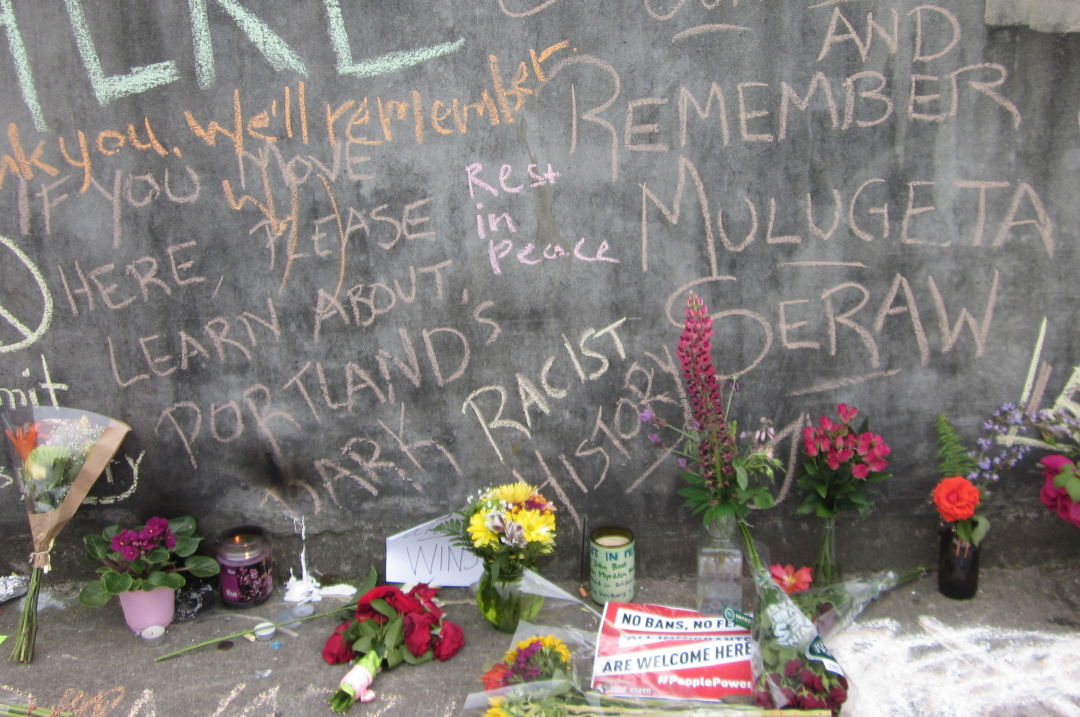Sad, Bad Times: A Look at the Darker Side of Portland’s Past

The name of Mulugeta Seraw, murdered in Southeast Portland in 1988, was invoked in the spontaneous memorial that sprang up at the Hollywood Transit Center in 2017 after a white supremacist stabbed three men who came to the defense of two young women of color he was harassing. These two hate crimes, three decades apart, are far from anomalies in Portland’s history.
Image: Margaret Seiler
Welcome to Portland! If there’s a city in the country that fosters creativity, sustainability, and ingenuity more than ours, we sure haven’t found it. Yet in the shadows of the ideals that make this place great lurks a long, painful history of discrimination, one that persists today in gruesome hate crimes and ongoing systemic inequities. To many white Portlanders, this history might go unseen or unacknowledged. But longtime discrimination has shaped the landscape of our city at its deepest levels. Here are just a few examples.
Black Exclusion Laws
Oregon’s history of racism can be traced back to the state’s beginning. When we joined the Union in 1859, we were the only state that banned Black people from living within its borders. This exclusion was in the state constitution until 1926. No wonder Portland remains one of the whitest big cities in the country, with more than 70 percent of residents classified as white non-Hispanic. Learn more from the Oregon Encyclopedia.
Japanese Internment
The 1941 bombing of Pearl Harbor increased anti-Japanese sentiment in Oregon and elsewhere. In 1942, Franklin Roosevelt’s Executive Order 9066 forced Americans of Japanese descent on the West Coast out of their homes and into detention centers hundreds of miles away. Released in 1945, they returned home to “No Japs Allowed” signs in storefronts, racist vigilante retaliation, just a quarter of the land they’d held before incarceration, and loud calls from the likes of Walter Pierce (a KKK-endorsed former Oregon governor and congressman) that they shouldn’t even come back. Learn more through the Japanese American Museum of Oregon.
Vanport Flood
World War II saw a huge infux of new Portlanders, many drawn by jobs in shipbuilding and other wartime industries. Where would they all live? Enter Vanport. Hastily built as worker housing for around 40,000 people on a flood plain that’s now home to Heron Lakes Golf Course and the Portland International Raceway, it was the second-largest city in Oregon (though it was never incorporated) and had some 6,000 Black residents. When the war ended, it was harder for Vanport’s Black residents than for its white ones to move elsewhere in Portland due to redlining and other racist practices, so many remained in what was meant to be temporary worker housing. Some Japanese families who had lost their homes in the internment and many returning vets also moved in after the war. In the wet spring of 1948, a railway embankment gave way, and Vanport was swept away mere hours after its residents had been told by the Portland housing authority the dikes were safe and they shouldn’t “get excited.” At least 15 people died in the flood. Experience the history through Vanport Mosaic.
Murder of Mulugeta Seraw
On November 13, 1988, at SE 31st and Pine, three members of a local hate group called East Side White Pride murdered Ethiopian student Mulugeta Seraw with a baseball bat. A high-profile trial followed against the White Aryan Resistance and the hate group’s California-based president, accused of encouraging racist acts of violence and conspiracy to commit murder. The trial and brutality of the crime brought to light some of the most hateful parts of our city that had often gone unseen or ignored. In 2018, a series of toppers honoring Seraw were added to street signs in the blocks surrounding the scene of the crime. Read about recent incidents tracked by Oregon Coalition United Against Hate.

This story originally appeared in print in the 2019 Portland Monthly Newcomer’s Guide.




